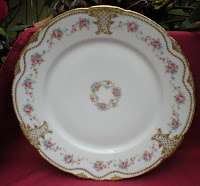
Continuing with Antique Haviland Limoges China Pattern Identification -
As mentioned previously, the best and most complete source for Haviland Limoges pattern identification are Arlene Schleiger's books. These books are divided into sections based on the back marks mentioned in an earlier blog. Once you have identified the Haviland maker you know which section in these books to look for your pattern. The main problem with Ms Schleiger's books is that the pictures are in black and white. Most were drawn from a saucer or small plate.


Look very closely at the pattern you wish to identify - preferably on a saucer or small plate if available. Is it a border design or is it scattered all over the piece? Try to imagine it in black and white.



Observe what it is that makes this design unique. This could be the shape of the flower - but since so many are roses this may not be the best starting point. Many patterns have other flowers mixed with the roses - concentrate on them.


Be aware of the placement of the flowers in the pattern - do they loop, are they garlands, do some of the flowers drop to the center of the plate?
The shape of the leaf is often distinctive.

The addition of ribbons, scrolls or lattices amongst the flowers is perhaps the most helpful in narrowing the pattern identification.








Once the pattern is identified with its Schleiger number, most often there are many variations of that pattern. These variations may be in the color of the design, the shape of the blank, the gold trim or lack of it. Sometimes it takes many trips through all of the books to identify a Haviland pattern.
Needless to say, identifying an Antique Haviland Limoges China Pattern can be most time consuming and often quite frustrating. When it is successful it is indeed an accomplishment!
It is always encouraging to verify an identification by looking at the color pictures in Nora Travis books on Haviland China. These books have lovely pictures of many patterns but are not complete identification guides.
Click on the pictures to be taken directly to their store pages and for specific pattern identification.
(Click on the banner to visit Holly Lane Antiques Internet Store)








































